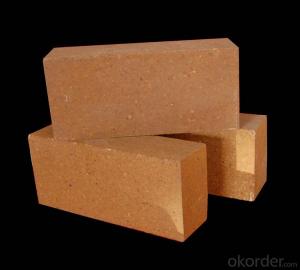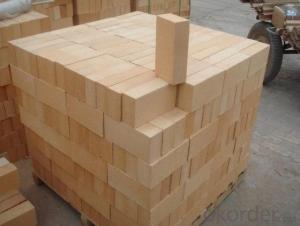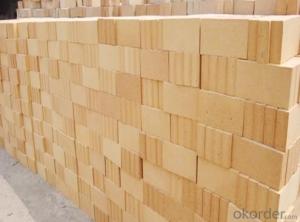Quality Refractory Insulation Fire Brick
- Loading Port:
- China main port
- Payment Terms:
- TT OR LC
- Min Order Qty:
- 30 m.t.
- Supply Capability:
- 10000 m.t./month
OKorder Service Pledge
OKorder Financial Service
You Might Also Like
CNBM Alumina Fire Brick are classified according to alumina content ranging from 48% to 90%.
CNBM Alumina Fire Brick are commonly used in blast furnace, hot blast furnace, the roof of electric furnace, teeming ladle, rotary kiln, regenerator, etc.
Insulating Fire Brick Technical index
Product No. | IFB70 | IFB60 | IFB50 | IFB40 |
Al2O3 | 68%-72% | 58%-62% | 48%-52% | 38%-40% |
Refractoriness (°C ) | ≥1790 | ≥1790 | ≥1790 | ≥1790 |
Bulk density (g/cm3) | 2.50-2.60 | 2.35-2.45 | 2.20-2.30 | 2.10-2.20 |
Apparent porosity (%) | 22 | 19-22 | 17-20 | 17-20 |
Cold Crushing strength (kg) | 480-510 | 450-480 | 430-450 | 390-430 |
Application
Insulating Fire Brick are used for the lining of converter, alternating current arc furnace, direct Current arc furnace and the ladle slag line, etc.
Equipment
1 unit of Ceramic Abrasive (SG Abrasive) pilot production line
2 units of Compact grain Abrasive pilot production lines
1 unit of high-end coated abrasives (abrasive cloth) production line
Company Advantage
(1)Long Insulating Fire Brick manufacture history: 25 years manufacturer
(2)Advanced equipment
(3)Diversification of production standards: ISO ANSI FEPA JIS ASTM
(4)Flexible payment: T/T L/C D/P D/A
(5)Professional marketing team and after-sale service
(6)Free sample
FAQs
Q1 |
What’s the transport method? |
A1 | FCL delivery goods with wooden pallet or wooden case by sea; If LCL delivery, must with wooden case; Sometimes need open top, flat rack or bulk cargo. |
Q2 |
What’s the required payment term? |
A2 | Generally 30% TT as the prepayment, 70% TT before delivery. If need, 100% Irrevocable Letter of Credit or negotiation. |
Q3 |
Which country are our products exported to? |
A3 | Apart from entire Chinese market, the US, Russia, Japan, Korea, Australia and some Southeast Asian Nations. |
- Q:Can insulating fire bricks be used in ceramic kilns?
- Yes, insulating fire bricks can be used in ceramic kilns. These bricks are designed to have high insulating properties, making them ideal for maintaining heat within the kiln. They are lightweight and can withstand high temperatures, making them a suitable choice for ceramic kilns.
- Q:Can insulating fire bricks be used in high-temperature filters?
- Yes, insulating fire bricks can be used in high-temperature filters. Insulating fire bricks are designed to withstand extremely high temperatures, typically up to 3000°F (1650°C). They have excellent thermal insulation properties, low thermal conductivity, and high resistance to thermal shock, making them ideal for applications that involve high temperatures. In high-temperature filters, insulating fire bricks can be used to form the structure of the filter, ensuring that it can withstand the intense heat generated. These bricks can be arranged in a way that allows for efficient filtration of gases or liquids while maintaining their structural integrity at high temperatures. The insulating properties of these bricks also help to minimize heat loss and maximize energy efficiency. Furthermore, insulating fire bricks are often chemically inert and have good resistance to corrosive substances, making them suitable for use in various industrial processes that involve the filtration of aggressive or hazardous materials at high temperatures. Overall, the use of insulating fire bricks in high-temperature filters provides a reliable and durable solution for filtering applications that require resistance to extreme temperatures.
- Q:Are insulating fire bricks suitable for use in residential fireplaces?
- Depending on the homeowner's specific requirements and preferences, insulating fire bricks can be a suitable option for residential fireplaces. These bricks are designed to have low thermal conductivity, which effectively retains heat and prevents its escape from the fireplace. Consequently, less heat is lost through the bricks, resulting in more efficient and effective heating of the room. Moreover, insulating fire bricks are lightweight and easy to handle, making them a convenient choice for homeowners who wish to install or replace bricks themselves. Additionally, they are durable and can withstand high temperatures, ensuring their longevity when exposed to the intense heat produced by the fire. Nevertheless, it is crucial to recognize that insulating fire bricks may not be ideal for everyone. Traditional fire bricks, being denser with higher thermal mass, can absorb and radiate heat for a longer duration. This attribute creates a more consistent and long-lasting heat output, which may be preferred by some homeowners. Ultimately, the decision to use insulating fire bricks in a residential fireplace should be based on the specific needs and preferences of the homeowner. Seeking guidance from a professional fireplace installer or a reputable supplier can help ensure that the chosen bricks are suitable for the intended use.
- Q:Can insulating fire bricks be used in the construction of glass melting tanks?
- Indeed, the utilization of insulating fire bricks is possible for the construction of glass melting tanks. These bricks are precisely engineered to endure elevated temperatures and offer exceptional insulation characteristics. Thus, they prove to be perfect for application in glass melting tanks, where intense temperatures are necessary for the glass to melt. The insulation properties of these bricks aid in minimizing heat dissipation and preserving the desired temperature within the tank, thereby enhancing the efficiency and cost-effectiveness of the glass melting procedures. Moreover, the durability and thermal shock resistance of insulating fire bricks make them a dependable option for constructing glass melting tanks.
- Q:Are insulating fire bricks resistant to flame impingement?
- Yes, insulating fire bricks are resistant to flame impingement.
- Q:Can insulating fire bricks be used as a refractory material?
- Yes, insulating fire bricks can be used as a refractory material. Insulating fire bricks have excellent thermal insulation properties and can withstand high temperatures, making them suitable for use in various refractory applications such as furnaces, kilns, and insulation linings.
- Q:How do insulating fire bricks affect the overall cost of a project?
- The overall cost of a project can be greatly affected by insulating fire bricks, both in terms of immediate expenses and long-term savings. Despite their higher upfront cost compared to traditional bricks, insulating fire bricks offer superior insulation properties, resulting in substantial cost savings over time. Retaining heat and preventing heat transfer are among the primary advantages of insulating fire bricks. This leads to reduced energy consumption and lower utility bills, as less energy is needed to heat or cool a space. In industrial settings, insulating fire bricks can optimize the efficiency of furnaces, kilns, and other high-temperature equipment, resulting in increased productivity and lower operational costs. Furthermore, insulating fire bricks provide excellent thermal insulation, creating a stable and comfortable indoor environment. This is particularly beneficial in residential and commercial construction, as it reduces reliance on heating and cooling systems, further reducing energy consumption and associated costs. In addition to their insulation properties, insulating fire bricks are highly durable and resistant to high temperatures, chemical corrosion, and mechanical stress. This durability minimizes the need for frequent repairs or replacements, leading to long-term cost savings. Their lightweight nature also makes them easy to handle and install, potentially reducing labor costs during construction. Moreover, insulating fire bricks have a longer lifespan compared to traditional bricks, resulting in lower maintenance and replacement costs over time. Their ability to withstand extreme temperatures and harsh environmental conditions means they are less likely to deteriorate or require frequent repairs. In conclusion, despite their higher initial cost, insulating fire bricks offer superior insulation properties, energy efficiency, durability, and reduced maintenance needs, leading to significant cost savings throughout a project's lifespan. When evaluating the overall cost-effectiveness of using insulating fire bricks in a construction or industrial project, it is important to consider the long-term benefits and potential energy savings.
- Q:Can insulating fire bricks be used in ceramic fiber boards?
- Insulating fire bricks have the potential to be utilized in ceramic fiber boards. They are commonly employed as a lining material for high-temperature purposes due to their ability to endure extremely high temperatures and offer exceptional thermal insulation. Conversely, ceramic fiber boards are lightweight and possess commendable thermal shock resistance, rendering them suitable for employment in diverse industrial and residential settings. When utilized in conjunction, insulating fire bricks can be positioned behind or around the ceramic fiber boards to augment their insulating properties and elevate overall thermal efficiency. The bricks have the capability to provide additional structural support and assist in retaining heat within the system, thereby enhancing energy efficiency and minimizing heat loss. Nevertheless, it is crucial to acknowledge that the compatibility of insulating fire bricks and ceramic fiber boards might fluctuate based on the specific application and requirements. It is advisable to seek guidance from manufacturers or industry professionals to ensure appropriate selection and installation of these materials according to your individual needs.
- Q:Can activated carbon be antiseptic?
- Activated carbon is also called activated carbon black. It is black, powder or lump, granular, cellular amorphous carbon, and also arranged crystal carbon.
- Q:Are insulating fire bricks suitable for insulation in walls?
- Typically, insulating fire bricks are unsuitable for wall insulation. Although they excel in high-temperature settings, like furnaces or kilns, their insulation capabilities for walls are limited. Insulating fire bricks possess lower thermal conductivity than regular bricks, resulting in slower heat conduction. Nevertheless, they are not as effective as wall-specific insulation materials such as fiberglass, foam boards, or mineral wool. These materials are engineered to offer superior insulation properties, including higher R-values that measure resistance to heat transfer. Furthermore, insulating fire bricks tend to be pricier and heavier compared to other insulation options, making them less practical for wall insulation. Therefore, while insulating fire bricks do have advantages in certain applications, they are generally not the optimal choice for wall insulation.
1. Manufacturer Overview |
|
|---|---|
| Location | |
| Year Established | |
| Annual Output Value | |
| Main Markets | |
| Company Certifications | |
2. Manufacturer Certificates |
|
|---|---|
| a) Certification Name | |
| Range | |
| Reference | |
| Validity Period | |
3. Manufacturer Capability |
|
|---|---|
| a)Trade Capacity | |
| Nearest Port | |
| Export Percentage | |
| No.of Employees in Trade Department | |
| Language Spoken: | |
| b)Factory Information | |
| Factory Size: | |
| No. of Production Lines | |
| Contract Manufacturing | |
| Product Price Range | |
Send your message to us
Quality Refractory Insulation Fire Brick
- Loading Port:
- China main port
- Payment Terms:
- TT OR LC
- Min Order Qty:
- 30 m.t.
- Supply Capability:
- 10000 m.t./month
OKorder Service Pledge
OKorder Financial Service
Similar products
New products
Hot products
Related keywords



























